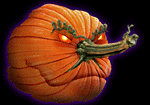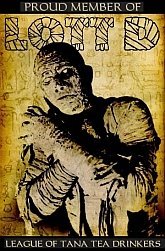
Tap Dancing to Hell and a Pot o'Gold Part 3 (Part 2)
Zombos Says: Classic
"Do you see him?" asked Curly Joe.
"No." I shone my flashlight down the long tunnel. "This is just great."
The tunnel we were standing in was long, narrow, and filled with doors; ominous, gray, metal-clad doors that practically screamed "Stay Out!" They were the types of doors you see in movies like Hostel. I hate doors like that.
"What's this?" he asked.
“‘Help Zombos Go Home,’” I read out loud, in the dim light of my flashlight. The large letters were written in script across the brick wall, with a kid’s pink chalk stick by the look of it.
"Who the hell’l want ta write in pink chalk down here?”
"No, not chalk," I said, touching it with my fingertip and tasting it. "Like chalk, I'd say."
"I should’a listened ta the other plumbers ‘bout this place. Now I’m playin’ in Zork-land." He sat on his rump and put his head in his hands. "Ya realize yer gonna get one hell of a bill, don't ya?"
Zombos pays the bills so I ignored him. "You know, this writing reminds me of that scary Shirley Jackson ghost story directed by Robert Wise, The Haunting."
Curly Joe perked up. "Say, I remember dat movie; pretty scary, even though ya never see any ghosts."
![]()
Perhaps this is the best way to describe The Haunting: a frightening ghost story because it doesn't show any ghosts. Unlike today’s vivid use of Japanese Onryô apparitions—in need of a shampoo and cut—vindictively mauling everyone onscreen, Wise only suggests ghosts, creating one of the scariest movies by sound and implication.
Taken from Jackson’s novel, The Haunting of Hill House, Nelson Gidding’s psychological screenplay uses her ambiguous supernatural inferences occurring within the house and leaves out those happening outside (such as the unsettling phantom picnic); keeping the tension-building squarely in the house as Dr. Markway's (Richard Johnson) skittish paranormal investigators experience the teasingly malevolent manifestations of Hill House’s former tenants.
In the foreboding opening montage, Dr. Markway relates the sordid history of Hill House, from the tragic death of Hugh Crain's first wife before she actually sees the morose mansion, to the mysterious death of his second wife down a long flight of, and finally the suicide of Abigail’s nurse-companion. Abigail was Hugh Crain’s repressed daughter. The companion, who inherited the estate because there was no one else to give it to after Abigail died a lonely death, hung herself from the wrought-iron spiral staircase in the sunless library; perhaps because she was never really left alone in the sprawling, gloomy house.
Clearly, Hill House has issues, and that's what draws the attention of Dr. Markway: he's looking for "the key to another world," and believes Hill House will provide it. And boy does it do so with relish. As he assembles his team from the dwindling group of people that still dare to enter Hill House after they learn about its unsavory past, he chooses Eleanor (Julie Harris), a fragile woman with no life of her own. She's a walking, living, ghost herself, and after spending the last eleven years taking care of her invalid mother, has nothing to call her own: not a relationship, not a career, not a hobby, not even her own place to live. She sees Dr. Markway's invitation as her great escape, her final chance to spread her wings and breathe freedom. This makes her dangerously vulnerable to the influences of Hill House. And Abigail, whose declining years were spent isolated, with only her companion to provide company.
Another member of Dr. Markway's team is Theo, a psychic sponge who knows everyone intimately on first meeting. She’s hip, she’s smart, and she takes a fancy to Eleanor, but Eleanor's fancy is tickled more by Dr. Markway, which leads to earthly tension in a house where Hugh Crane derided earthly pleasures. Just look at the ugly bible illustrations of damnation for the wicked he foisted on poor little Abigail: it’s the proverbial bible for horror movie victimology 101: enjoy thyself and die, oh wicked one!
Luke (Russ Tamblyn) is the skeptic. Not part of Dr. Markway’s team, he's there because he's inheriting the house and wants to look after his future interests. He doesn't believe in spirits unless they’re bottled. Tamblyn’s Luke is armed with quick-with-a-quip resolve. He jokes to dispel the awkward feeling the unknown gives him when explanations are needy.
Julie Harris, Wise's choice for the role of Eleanor, or Nell as Theo calls her, is the character everyone and everything in the house becomes enamored with. Her clumsy shyness hides her need to desperately belong somewhere, anywhere, even if it is here; and Claire Bloom's alluring but predatory "nature's mistake" Theo resents the house's need for Nell as much as she resents her own need for Nell. Both women alternately bond, break apart, and bond again, trading biting insults as their relationship becomes as difficult to navigate as the house’s hallways.
The outside shots of Hill House—in actuality the Ettington Park Hotel in England—are made even more ominously brooding by Wise's shrewd use of infra-red movie to sharpen and darken the arched, neo-gothic windows and towering brick facade to the point of austerity. His technique of darkening the mansion under angry clouds, when a supernatural event is about to happen, cues the chills for us even more. Choosing the naturally more gritty and spooky quality of black and white movie stock over color also intensifies the brooding interplay of stark shadows and lightness in the interiors of the mansion, emphasizing the not-quite-right nature of the house that Hugh Crain built, where doors shut themselves, walls meet at odd angles, and "nothing seems to move until you look away."
Looking for ways to enhance the foreboding atmosphere of his movie, Wise jumped at the chance to use a newly available prototype 35mm lens that presented a slight distortion for his Panavision landscape, increasing the unnaturalness of the mansion's rooms and exteriors in a subtle way. He had to sign a waiver releasing the manufacturer from any liability before he could acquire it (Bryan Senn, Cinematic Hauntings).
Wise's unique visual styling of the movie aside, it's his minimalist depiction of terrifying events assailing Nell and Theo that turn The Haunting into a classic, adult tale of suspenseful frights. The violent nighttime encounter with something conspicuously making its way through the halls to find them in their bedroom, the intense pounding on the door, the scuffling, and the heart-stopping turning doorknob as it seeks to get in is a nerve-tingling blend of spiraling camera work, fearful reactions as Nell and Theo look to each other for support, and loud, disorientating banging following by silence. This impression of what may be trying to get in generates genuine scares. I dare you to watch this late at night and alone.
Wise builds friction between the investigators as Nell begins to lose herself to the intoxicating and liberating influence of Hill House, between alternating bouts of willingness and reluctance. As a kindred spirit—albeit a living one—to Abigail's companion, it is never made clear who or what exactly is enamored with Nell aside from Theo. Is it Abigail, seeking a companion again, or is it the companion, trapped alone, seeking release from a vengeful Abigail?
‘Help Eleanor Come Home,’ found written in large letters with "something like chalk," is seen on a hallway wall. Dr. Markway now realizes what we already know: how vulnerable Nell really is to this key to another world. One side of him wants Eleanor to leave for her own safety, but the other realizes she is the lightning rod, the attractor for the haunting. Or is he becoming more amenable to Nell’s obvious infatuation with him, or maybe he’s concerned she has no other place to go?
When Dr. Markway's wife (Lois Maxwell), another skeptic, unexpectedly visits, pleading with him to end his ridiculous ghost-hunting nonsense, Nell, in a fit of jealous pique, mentions the nursery when Mrs. Markway asks for the scariest room to sleep in. Although Nell realizes the seriousness of what she said—the nursery is the evil heart of Hill House—Mrs. Markway insists on staying in the room. Although Mrs. Markway refuses to stay with the others, Dr. Markway insists everyone else spend the night together for safety, while he and Luke take turns watching the nursery for any sign of trouble. When Luke sneaks into the parlor for a quick, fortifying drink, the door slams shut with a loud bang, waking the others. Once again, a door becomes the only separation between the living and the unknown, and Luke comes to an abrupt realization that he'll have a lot of trouble trying to sell Hill House. Wise ups the ante for terror here with a simple, non-CGI, effect that will send chills down your spine.
When whatever is doing the pounding heads upstairs to the nursery, Luke, now a card-carrying believer in the supernatural, fights Dr. Markway to keep the door closed, and Nell, visibly and metaphorically, retreats into the bowels of Hill House. Like Abigail's companion, she heads to the library where, at the top of the rickety spiral staircase, she contemplates a similar fate.
Will Hill House have what it wants? Will Eleanor? What happens to Mrs. Markway? Will she live long enough to become a believer in the supernatural, too?
The Haunting must be watched at night with the lights off, or in a darkened theater, well into the evening. It is a sophisticated, well-crafted foray into the ghostly realm, and one that will leave you exhilarated and scared and happy such horror movies still may be found.
Do not confuse this movie with its befuddled remake.
This one’s the real scary deal.








